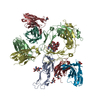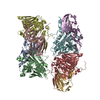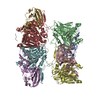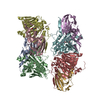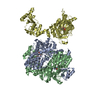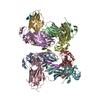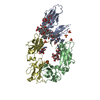[English] 日本語
 Yorodumi
Yorodumi- EMDB-25136: Structure of a partially disrupted IgE high affinity receptor com... -
+ Open data
Open data
- Basic information
Basic information
| Entry | Database: EMDB / ID: EMD-25136 | |||||||||
|---|---|---|---|---|---|---|---|---|---|---|
| Title | Structure of a partially disrupted IgE high affinity receptor complex bound to an omalizumab variant | |||||||||
 Map data Map data | ||||||||||
 Sample Sample |
| |||||||||
| Function / homology |  Function and homology information Function and homology informationhigh-affinity IgE receptor activity / IgE B cell receptor complex / adaptive immune memory response / primary adaptive immune response / type I hypersensitivity / B cell antigen processing and presentation / Fc receptor-mediated immune complex endocytosis / eosinophil degranulation / IgE immunoglobulin complex / macrophage activation ...high-affinity IgE receptor activity / IgE B cell receptor complex / adaptive immune memory response / primary adaptive immune response / type I hypersensitivity / B cell antigen processing and presentation / Fc receptor-mediated immune complex endocytosis / eosinophil degranulation / IgE immunoglobulin complex / macrophage activation / IgE binding / type 2 immune response / Fc epsilon receptor (FCERI) signaling / antibody-dependent cellular cytotoxicity / mast cell degranulation / B cell proliferation / macrophage differentiation / immunoglobulin mediated immune response / Role of LAT2/NTAL/LAB on calcium mobilization / immunoglobulin complex, circulating / immunoglobulin receptor binding / FCERI mediated Ca+2 mobilization / complement activation, classical pathway / FCERI mediated MAPK activation / antigen binding / B cell receptor signaling pathway / FCERI mediated NF-kB activation / antibacterial humoral response / Interleukin-4 and Interleukin-13 signaling / adaptive immune response / cell surface receptor signaling pathway / blood microparticle / inflammatory response / immune response / external side of plasma membrane / cell surface / extracellular space / extracellular exosome / extracellular region / plasma membrane Similarity search - Function | |||||||||
| Biological species |  Homo sapiens (human) Homo sapiens (human) | |||||||||
| Method | single particle reconstruction / cryo EM / Resolution: 7.29 Å | |||||||||
 Authors Authors | Pennington LF / Jardetzky TS | |||||||||
| Funding support |  United States, 2 items United States, 2 items
| |||||||||
 Citation Citation |  Journal: Nat Commun / Year: 2021 Journal: Nat Commun / Year: 2021Title: Directed evolution of and structural insights into antibody-mediated disruption of a stable receptor-ligand complex. Authors: Luke F Pennington / Pascal Gasser / Silke Kleinboelting / Chensong Zhang / Georgios Skiniotis / Alexander Eggel / Theodore S Jardetzky /   Abstract: Antibody drugs exert therapeutic effects via a range of mechanisms, including competitive inhibition, allosteric modulation, and immune effector mechanisms. Facilitated dissociation is an additional ...Antibody drugs exert therapeutic effects via a range of mechanisms, including competitive inhibition, allosteric modulation, and immune effector mechanisms. Facilitated dissociation is an additional mechanism where antibody-mediated "disruption" of stable high-affinity macromolecular complexes can potentially enhance therapeutic efficacy. However, this mechanism is not well understood or utilized therapeutically. Here, we investigate and engineer the weak disruptive activity of an existing therapeutic antibody, omalizumab, which targets IgE antibodies to block the allergic response. We develop a yeast display approach to select for and engineer antibody disruptive efficiency and generate potent omalizumab variants that dissociate receptor-bound IgE. We determine a low resolution cryo-EM structure of a transient disruption intermediate containing the IgE-Fc, its partially dissociated receptor and an antibody inhibitor. Our results provide a conceptual framework for engineering disruptive inhibitors for other targets, insights into the failure in clinical trials of the previous high affinity omalizumab HAE variant and anti-IgE antibodies that safely and rapidly disarm allergic effector cells. | |||||||||
| History |
|
- Structure visualization
Structure visualization
| Movie |
 Movie viewer Movie viewer |
|---|---|
| Structure viewer | EM map:  SurfView SurfView Molmil Molmil Jmol/JSmol Jmol/JSmol |
| Supplemental images |
- Downloads & links
Downloads & links
-EMDB archive
| Map data |  emd_25136.map.gz emd_25136.map.gz | 59.8 MB |  EMDB map data format EMDB map data format | |
|---|---|---|---|---|
| Header (meta data) |  emd-25136-v30.xml emd-25136-v30.xml emd-25136.xml emd-25136.xml | 16.4 KB 16.4 KB | Display Display |  EMDB header EMDB header |
| Images |  emd_25136.png emd_25136.png | 44.3 KB | ||
| Archive directory |  http://ftp.pdbj.org/pub/emdb/structures/EMD-25136 http://ftp.pdbj.org/pub/emdb/structures/EMD-25136 ftp://ftp.pdbj.org/pub/emdb/structures/EMD-25136 ftp://ftp.pdbj.org/pub/emdb/structures/EMD-25136 | HTTPS FTP |
-Validation report
| Summary document |  emd_25136_validation.pdf.gz emd_25136_validation.pdf.gz | 401.7 KB | Display |  EMDB validaton report EMDB validaton report |
|---|---|---|---|---|
| Full document |  emd_25136_full_validation.pdf.gz emd_25136_full_validation.pdf.gz | 401.2 KB | Display | |
| Data in XML |  emd_25136_validation.xml.gz emd_25136_validation.xml.gz | 6.3 KB | Display | |
| Data in CIF |  emd_25136_validation.cif.gz emd_25136_validation.cif.gz | 7.2 KB | Display | |
| Arichive directory |  https://ftp.pdbj.org/pub/emdb/validation_reports/EMD-25136 https://ftp.pdbj.org/pub/emdb/validation_reports/EMD-25136 ftp://ftp.pdbj.org/pub/emdb/validation_reports/EMD-25136 ftp://ftp.pdbj.org/pub/emdb/validation_reports/EMD-25136 | HTTPS FTP |
-Related structure data
| Related structure data |  7shtMC  7shuC  7shyC  7shzC  7si0C M: atomic model generated by this map C: citing same article ( |
|---|---|
| Similar structure data |
- Links
Links
| EMDB pages |  EMDB (EBI/PDBe) / EMDB (EBI/PDBe) /  EMDataResource EMDataResource |
|---|---|
| Related items in Molecule of the Month |
- Map
Map
| File |  Download / File: emd_25136.map.gz / Format: CCP4 / Size: 64 MB / Type: IMAGE STORED AS FLOATING POINT NUMBER (4 BYTES) Download / File: emd_25136.map.gz / Format: CCP4 / Size: 64 MB / Type: IMAGE STORED AS FLOATING POINT NUMBER (4 BYTES) | ||||||||||||||||||||||||||||||||||||||||||||||||||||||||||||
|---|---|---|---|---|---|---|---|---|---|---|---|---|---|---|---|---|---|---|---|---|---|---|---|---|---|---|---|---|---|---|---|---|---|---|---|---|---|---|---|---|---|---|---|---|---|---|---|---|---|---|---|---|---|---|---|---|---|---|---|---|---|
| Voxel size | X=Y=Z: 0.8521 Å | ||||||||||||||||||||||||||||||||||||||||||||||||||||||||||||
| Density |
| ||||||||||||||||||||||||||||||||||||||||||||||||||||||||||||
| Symmetry | Space group: 1 | ||||||||||||||||||||||||||||||||||||||||||||||||||||||||||||
| Details | EMDB XML:
CCP4 map header:
| ||||||||||||||||||||||||||||||||||||||||||||||||||||||||||||
-Supplemental data
- Sample components
Sample components
-Entire : Locked complex of IgE-Fc (G335C) and alpha chain of the high affi...
| Entire | Name: Locked complex of IgE-Fc (G335C) and alpha chain of the high affinity IgE receptor (W156C) bound to clone_7 scFV |
|---|---|
| Components |
|
-Supramolecule #1: Locked complex of IgE-Fc (G335C) and alpha chain of the high affi...
| Supramolecule | Name: Locked complex of IgE-Fc (G335C) and alpha chain of the high affinity IgE receptor (W156C) bound to clone_7 scFV type: complex / ID: 1 / Parent: 0 / Macromolecule list: #1-#4 |
|---|---|
| Source (natural) | Organism:  Homo sapiens (human) Homo sapiens (human) |
| Recombinant expression | Organism:  Homo sapiens (human) Homo sapiens (human) |
-Macromolecule #1: High affinity immunoglobulin epsilon receptor subunit alpha
| Macromolecule | Name: High affinity immunoglobulin epsilon receptor subunit alpha type: protein_or_peptide / ID: 1 / Number of copies: 1 / Enantiomer: LEVO |
|---|---|
| Source (natural) | Organism:  Homo sapiens (human) Homo sapiens (human) |
| Molecular weight | Theoretical: 22.541799 KDa |
| Recombinant expression | Organism:  Homo sapiens (human) Homo sapiens (human) |
| Sequence | String: APMAEGGGQN HHHHHHHHGG ENLYFQGGSP KVSLNPPWNR IFKGENVTLT CNGNNFFEVS STKWFHNGSL SEETNSSLNI VNAKFEDSG EYKCQHQQVN ESEPVYLEVF SDWLLLQASA EVVMEGQPLF LRCHGWRNWD VYKVIYYKDG EALKYWYENH N ISITNATV ...String: APMAEGGGQN HHHHHHHHGG ENLYFQGGSP KVSLNPPWNR IFKGENVTLT CNGNNFFEVS STKWFHNGSL SEETNSSLNI VNAKFEDSG EYKCQHQQVN ESEPVYLEVF SDWLLLQASA EVVMEGQPLF LRCHGWRNWD VYKVIYYKDG EALKYWYENH N ISITNATV EDSGTYYCTG KVCQLDYESE PLNITVIKA |
-Macromolecule #2: Immunoglobulin heavy constant epsilon
| Macromolecule | Name: Immunoglobulin heavy constant epsilon / type: protein_or_peptide / ID: 2 / Number of copies: 2 / Enantiomer: LEVO |
|---|---|
| Source (natural) | Organism:  Homo sapiens (human) Homo sapiens (human) |
| Molecular weight | Theoretical: 35.77316 KDa |
| Recombinant expression | Organism:  Homo sapiens (human) Homo sapiens (human) |
| Sequence | String: ASFTPPTVKI LQSSCDGGGH FPPTIQLLCL VSGYTPGTIN ITWLEDGQVM DVDLSTASTT QEGELASTQS ELTLSQKHWL SDRTYTCQV TYQGHTFEDS TKKCADSNPR CVSAYLSRPS PFDLFIRKSP TITCLVVDLA PSKGTVNLTW SRASGKPVNH S TRKEEKQR ...String: ASFTPPTVKI LQSSCDGGGH FPPTIQLLCL VSGYTPGTIN ITWLEDGQVM DVDLSTASTT QEGELASTQS ELTLSQKHWL SDRTYTCQV TYQGHTFEDS TKKCADSNPR CVSAYLSRPS PFDLFIRKSP TITCLVVDLA PSKGTVNLTW SRASGKPVNH S TRKEEKQR NGTLTVTSTL PVGTRDWIEG ETYQCRVTHP HLPRALMRST TKTSGPRAAP EVYAFATPEW PGSRDKRTLA CL IQNFMPE DISVQWLHNE VQLPDARHST TQPRKTKGSG FFVFSRLEVT RAEWEQKDEF ICRAVHEAAS PSQTVQRAVS VNP GK |
-Macromolecule #3: clone_7 Variable fragment heavy chain
| Macromolecule | Name: clone_7 Variable fragment heavy chain / type: protein_or_peptide / ID: 3 / Number of copies: 2 / Enantiomer: LEVO |
|---|---|
| Source (natural) | Organism:  Homo sapiens (human) Homo sapiens (human) |
| Molecular weight | Theoretical: 13.451814 KDa |
| Recombinant expression | Organism:  Homo sapiens (human) Homo sapiens (human) |
| Sequence | String: ASEVQLVESG GGLVQPDGSL RLSCAVSGYN ITSGYSWNWI RQTPGKGLEW VASVTYDGST NYNPSVKGRI TISRDGSKNT FYLQMNSLR AEDTAVYYCA KGNNYFGHWH FAVWGQGTLV TVSS |
-Macromolecule #4: clone_7 Variable fragment light chain
| Macromolecule | Name: clone_7 Variable fragment light chain / type: protein_or_peptide / ID: 4 / Number of copies: 2 / Enantiomer: LEVO |
|---|---|
| Source (natural) | Organism:  Homo sapiens (human) Homo sapiens (human) |
| Molecular weight | Theoretical: 14.641863 KDa |
| Recombinant expression | Organism:  Homo sapiens (human) Homo sapiens (human) |
| Sequence | String: GSDIQLTQSP SSLSASVGDR VTITCRASKS VDSDGDSYMN WYQQKPGRAP KLLIYAASYL ESGVPSRFSG SGSGTHFTLT ISSLQPEDF ATYYCQQSHE DPYTFGQGTK VEIKGGSENL YFQGGSGHHH HHHHH |
-Macromolecule #8: 2-acetamido-2-deoxy-beta-D-glucopyranose
| Macromolecule | Name: 2-acetamido-2-deoxy-beta-D-glucopyranose / type: ligand / ID: 8 / Number of copies: 3 / Formula: NAG |
|---|---|
| Molecular weight | Theoretical: 221.208 Da |
| Chemical component information |  ChemComp-NAG: |
-Experimental details
-Structure determination
| Method | cryo EM |
|---|---|
 Processing Processing | single particle reconstruction |
| Aggregation state | particle |
- Sample preparation
Sample preparation
| Concentration | 4.5 mg/mL |
|---|---|
| Buffer | pH: 7.5 |
| Grid | Model: Quantifoil R1.2/1.3 / Material: GOLD / Mesh: 200 / Support film - Material: CARBON / Support film - topology: HOLEY / Pretreatment - Type: GLOW DISCHARGE |
| Vitrification | Cryogen name: ETHANE |
- Electron microscopy
Electron microscopy
| Microscope | TFS KRIOS |
|---|---|
| Image recording | Film or detector model: GATAN K3 (6k x 4k) / Number grids imaged: 1 / Number real images: 523 / Average exposure time: 2.0 sec. / Average electron dose: 44.0 e/Å2 |
| Electron beam | Acceleration voltage: 300 kV / Electron source:  FIELD EMISSION GUN FIELD EMISSION GUN |
| Electron optics | Illumination mode: SPOT SCAN / Imaging mode: BRIGHT FIELD |
| Experimental equipment |  Model: Titan Krios / Image courtesy: FEI Company |
+ Image processing
Image processing
-Atomic model buiding 1
| Initial model |
| ||||||||
|---|---|---|---|---|---|---|---|---|---|
| Details | Initial local fitting done in Chimera, followed by auto dock, and a single round of real space refinement. Carbohydrates were automatically built in phenix when possible, and a handful of flagged outliers in geometry were fixed manually in Phenix. | ||||||||
| Refinement | Protocol: FLEXIBLE FIT | ||||||||
| Output model |  PDB-7sht: |
 Movie
Movie Controller
Controller



